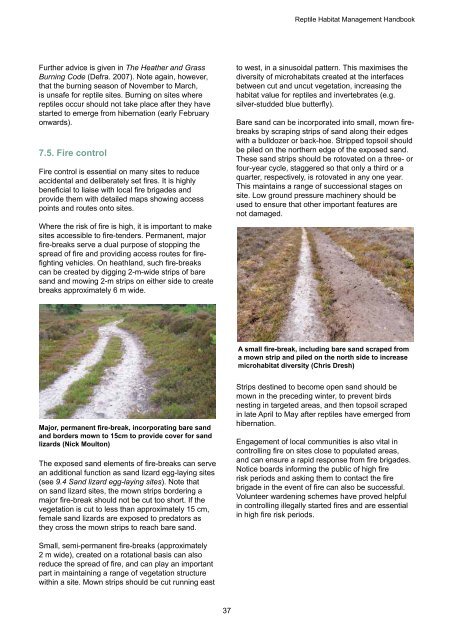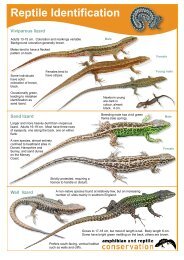reptile-habitat-management-handbook-ffull
reptile-habitat-management-handbook-ffull
reptile-habitat-management-handbook-ffull
Create successful ePaper yourself
Turn your PDF publications into a flip-book with our unique Google optimized e-Paper software.
Reptile Habitat Management Handbook<br />
Further advice is given in The Heather and Grass<br />
Burning Code (Defra. 2007). Note again, however,<br />
that the burning season of November to March,<br />
is unsafe for <strong>reptile</strong> sites. Burning on sites where<br />
<strong>reptile</strong>s occur should not take place after they have<br />
started to emerge from hibernation (early February<br />
onwards).<br />
7.5. Fire control<br />
Fire control is essential on many sites to reduce<br />
accidental and deliberately set fires. It is highly<br />
beneficial to liaise with local fire brigades and<br />
provide them with detailed maps showing access<br />
points and routes onto sites.<br />
Where the risk of fire is high, it is important to make<br />
sites accessible to fire-tenders. Permanent, major<br />
fire-breaks serve a dual purpose of stopping the<br />
spread of fire and providing access routes for firefighting<br />
vehicles. On heathland, such fire-breaks<br />
can be created by digging 2-m-wide strips of bare<br />
sand and mowing 2-m strips on either side to create<br />
breaks approximately 6 m wide.<br />
to west, in a sinusoidal pattern. This maximises the<br />
diversity of micro<strong>habitat</strong>s created at the interfaces<br />
between cut and uncut vegetation, increasing the<br />
<strong>habitat</strong> value for <strong>reptile</strong>s and invertebrates (e.g.<br />
silver-studded blue butterfly).<br />
Bare sand can be incorporated into small, mown firebreaks<br />
by scraping strips of sand along their edges<br />
with a bulldozer or back-hoe. Stripped topsoil should<br />
be piled on the northern edge of the exposed sand.<br />
These sand strips should be rotovated on a three- or<br />
four-year cycle, staggered so that only a third or a<br />
quarter, respectively, is rotovated in any one year.<br />
This maintains a range of successional stages on<br />
site. Low ground pressure machinery should be<br />
used to ensure that other important features are<br />
not damaged.<br />
A small fire-break, including bare sand scraped from<br />
a mown strip and piled on the north side to increase<br />
micro<strong>habitat</strong> diversity (Chris Dresh)<br />
Major, permanent fire-break, incorporating bare sand<br />
and borders mown to 15cm to provide cover for sand<br />
lizards (Nick Moulton)<br />
The exposed sand elements of fire-breaks can serve<br />
an additional function as sand lizard egg-laying sites<br />
(see 9.4 Sand lizard egg-laying sites). Note that<br />
on sand lizard sites, the mown strips bordering a<br />
major fire-break should not be cut too short. If the<br />
vegetation is cut to less than approximately 15 cm,<br />
female sand lizards are exposed to predators as<br />
they cross the mown strips to reach bare sand.<br />
Strips destined to become open sand should be<br />
mown in the preceding winter, to prevent birds<br />
nesting in targeted areas, and then topsoil scraped<br />
in late April to May after <strong>reptile</strong>s have emerged from<br />
hibernation.<br />
Engagement of local communities is also vital in<br />
controlling fire on sites close to populated areas,<br />
and can ensure a rapid response from fire brigades.<br />
Notice boards informing the public of high fire<br />
risk periods and asking them to contact the fire<br />
brigade in the event of fire can also be successful.<br />
Volunteer wardening schemes have proved helpful<br />
in controlling illegally started fires and are essential<br />
in high fire risk periods.<br />
Small, semi-permanent fire-breaks (approximately<br />
2 m wide), created on a rotational basis can also<br />
reduce the spread of fire, and can play an important<br />
part in maintaining a range of vegetation structure<br />
within a site. Mown strips should be cut running east<br />
37



